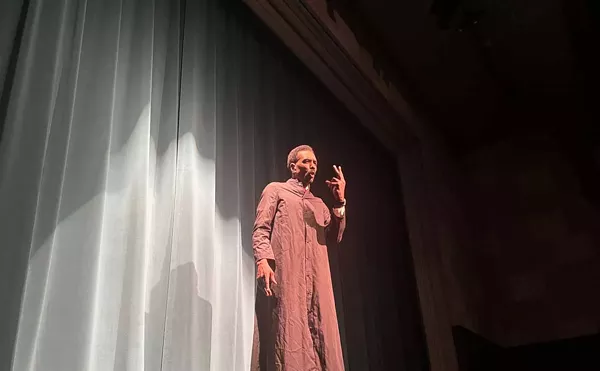
Audio By Carbonatix
[
{
"name": "GPT - Leaderboard - Inline - Content",
"component": "35519556",
"insertPoint": "5th",
"startingPoint": "3",
"requiredCountToDisplay": "3",
"maxInsertions": 100,
"adList": [
{
"adPreset": "LeaderboardInline"
}
]
}
]
There’s always an edge to our imagination where we’re on our own, where the facts of our concrete experience — what we’ve seen and touched — dissipate and we can only imagine or invent what’s possible. It’s a moment of raw and often embarrassing vulnerability. It’s a moment when we know who we really are by what we construct.
Peter White, an independent art curator from Montreal, has assembled an extraordinary exhibition at the Art Gallery of Windsor that investigates and challenges this part of our identity. “Out There is Somewhere: The Arctic in Pictures” is a beautiful and wiggy, psychologically probing exploration of Arctic culture (the ultimate tabula rasa of world geography) that gives us cause to think hard about how we look at, and what we make of, the rest of the world.
At the entrance to the exhibition, a montage of black-and-white historical footage is on a monitor where we can witness an enormous polar bear being harpooned. The animal flails about while “Eskimos” dance around to avoid its agonized thrashing. As the jaggedly cut video progresses, a mystically romantic vision of icebergs looms refracted through a cubist lens. This is followed by a sure-footed Eskimo hopping from one ice chunk to another, while a fantastic 19th century sailing vessel floats among mountainous icebergs. The horrifically lifeless polar bear is lifted by rope and pulley onto a ship and so on. “Out There is Somewhere” begins in this ironic and unsettling mode, setting the stage for a visual interrogation of our idea of the Arctic.
The exhibition is organized in three sections and is bookended by this historical footage and by contemporary Inuits’ representations of themselves. The first section goes from “pre-contact” times (before the arrival of European adventurers) to 1880 and is composed of an array of some 100 18th century and 19th century paintings, lithographs and drawings, as well as books and artifacts. The paintings depict every conceivable engagement with the Arctic, from multiple and subtly varied whale hunts and Arctic fox slaughters, to “anthropologic” representations of “Eskimos” (the word takes on a grotesque racism as the exhibition progresses). There are early Inuit drawings of the landscape, romantic views of a mythologized virgin territory and classic representations of magnificent sailing vessels depicting actual events.
While many of the paintings are remarkably beautiful in their innocent perception of the Arctic and while some of them achieve their intended heroic effect, others create an ironic absurdity, especially with such images as the Royal Canadian Mounted Police planting the Canadian flag in a snowbank. It slowly becomes apparent that this Arctic region is not only another site of European colonialism, but also a place where the colonizing mind can project all of its predispositions onto a white slate without engagement with what already exists there.
In the second section, 1880-1945, the Arctic becomes a highly charged fantasy for popular culture, especially as a result of Dr. Frederick Cook’s and Commander Robert Perry’s “race” to be the first to arrive at the “North Pole,” a place of course that exists only as a symbolic idea. While the first section employs paintings, the second uses an abundance of photographs and movie footage to document the mythologizing of the Arctic. Popular novels and movies romanticized the “barren wasteland” and man’s efforts to “conquer” it. Popular iconography of the fetishized Arctic is well-represented and again illuminates the cultural landscape that constructed such a fantasy. Wonderful photos of “first contact” with other cultural groups (such as Charles and Anne Lindbergh standing with Inuits beside their plane at Baker Lake) document these strange encounters.
On the other hand, paintings by some of Canada’s “Group of Seven” artists — Lawren Stuart Harris, A.Y. Jackson and Rockwell Kent — testify to a different process of negotiating this foreign and romantic landscape. Harris’ painting, North Shore, Baffin Island (1930, pictured), depicts a stylized landscape that, while elegant, attempts to bring the Arctic within the pictorial imagination of modernism and can be seen to be moving toward abstraction. A.Y. Jackson’s paintings range from romantic realism to formal abstraction and are perfect examples of imposing an existing tradition of painting on a new subject.
There are also many fine examples of Inuit drawing and painting where we see how the style of representation is perfectly wedded to the landscape. Both Peter Pitseolak and Etidlooie Etidlooie articulate in drawing a perfectly literal notion of white space (snow) around their subjects. Their narratives are painted as if floating in this space like cartoon word balloons. Pitseolak reflects the other side of the coin of the intersection of Inuit and white culture, and humorously depicts it in his watercolor, The Eskimo Will Talk Like the Whiteman (pictured), in which white people’s faces (including Clark Gable) are collaged onto traditional Inuit bodies and dress.
An extraordinary mass of materials contributes to Peter White’s open-ended meditation on the intersection of Arctic-Inuit and European, American and Canadian cultures. Robert Flaherty’s movie, Nanook of the North (excerpts of which run continuously), the first-ever documentary film about the Arctic, combines a very complex set of circumstances that perfectly illustrate White’s enlightening, ultimately objective investigation.
This romantic narrative about Nanook, an Inuit hero, and his gal, “smiling Nyla,” is situated around an anthropological study of life in the Arctic. The hunting, capture, butchering and eating of raw seal is presented in a hilarious “Man meets Nature” epic style, with everything from a Chaplinesque battle with the seal to the eye-opening vision of beautiful, smiling Nyla diving into some hot-off-the-bone raw seal meat.
It’s a film that, like Peter White’s whole passionately realized exhibition, makes one realize the often humiliating, socially tragic and comical nature of our hybridized identities.
“Out There is Somewhere: The Arctic in Pictures” is at the Art Gallery of Windsor (401 Riverside Drive W., Windsor) through May 26. Call 519-977-0013.
Glen Mannisto writes about visual art for Metro Times. E-mail him at letters@metrotimes.com




